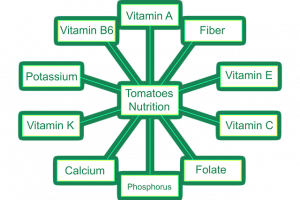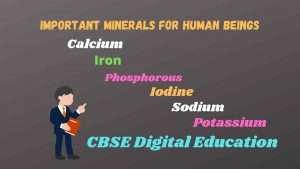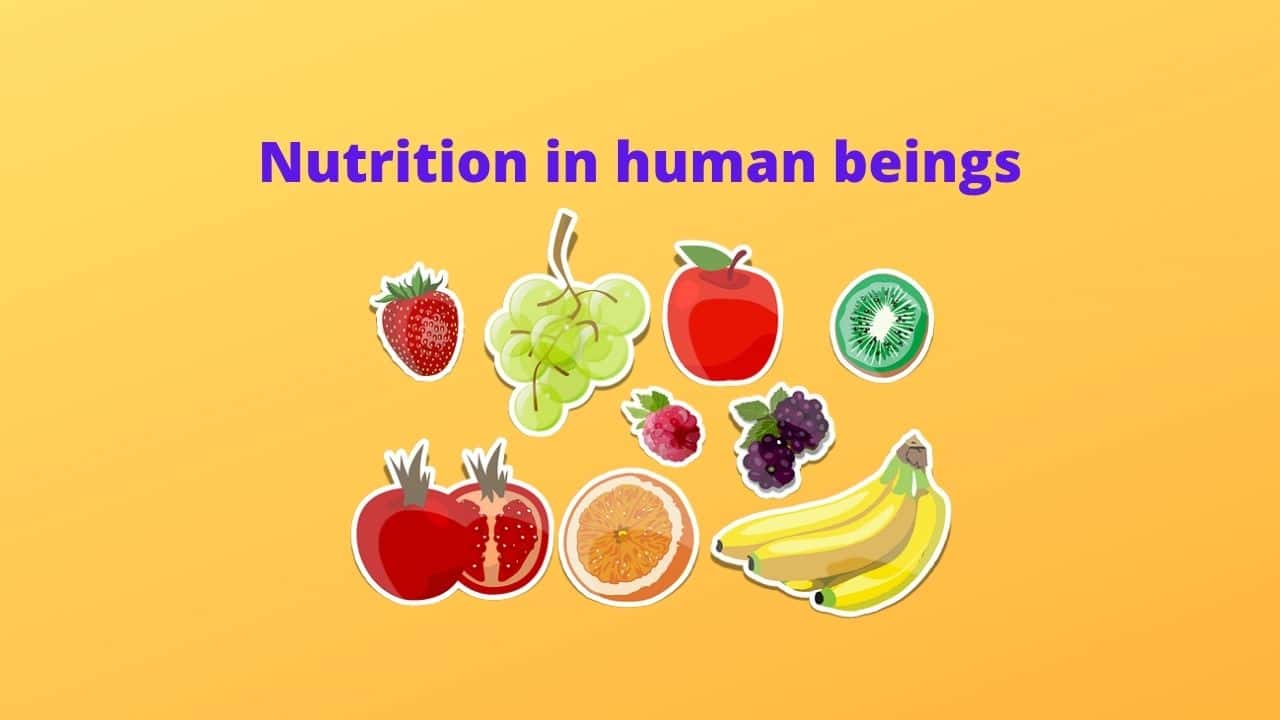Explain Nutrition in human beings: Food provides the energy to perform different functions. The intake of food by an organism, its absorption, and utilization in the body is called nutrition.

Human beings are Omnivores. Their food comes from plant sources as well as animal sources. We get cereals (wheat, maize, rice), pulses (urad, moong, gram), fruits (mango, guava, papaya), vegetables (potato, tomato, carrots) oils (groundnut, mustard, coconut, etc.) from plants. We also get eggs, meat, milk, etc from animals.
Main nutrition for human beings
There are 7 essential nutrition in human beings are:
- Carbohydrates
- Fats
- Protein
- Vitamin
- Minerals
- Dietary fibers
- Water

- Carbohydrates
Carbohydrates are made up of carbon (C), hydrogen (H), and oxygen (O). Examples of carbohydrates are sugars, glucose, starches, and cellulose.
An important fact about Carbohydrates
- The formula of carbohydrates = (CH2O)n
- Energy in 1 gram carbohydrate = 4.2 calorie
- Unit of carbohydrates = Saccharide
- Carbohydrates are energy molecules.
- Between two saccharide units, a Glycosidic Bond is formed.
Sources of Carbohydrate:
Grains like wheat, rice, millet, maize, sugarcane, potato, sweet potato, beetroot.
Function of carbohydrates
Carbohydrates provide energy to the body. Carbohydrates are broken down into sugars mainly glucose and oxidized to get energy.
- Fats
Fat is made up of fatty acids and glycerol. It is hydrophobic (not soluble in water). It is also called lipids. 9.3 calorie energy in 1 gram fat/lipid.
Sources of Fats
Milk, butter, ghee, cheese, cream, fish liver oil, vegetable oils (mustard, coconut, groundnut, sunflower, etc.)
Function of Fats
Fats provide energy to the body. Extra food is stored by the human body in the form of fats in the liver and under the skin. The human body needs fats to dissolve and use fat-soluble vitamins like vitamin A and vitamin D.
- Proteins
Proteins are made of nitrogen-containing compounds known as amino acids. It is an amphoteric molecule.
- Protein is an energy molecule.
- Protein is called the building block of life.
- It is a wound-healing energy molecule.
- Energy in 1 gram protein = 4.5 Calorie
- The human body is made up of 10-20 percent protein.
- The human body requires a total of 22 types of protein.
- Collagen protein is the most abundant protein in the human body.
Examples of Proteins: Thrombin, pro-thrombin, globin, globulin, fibrin, fibrinogen, keratin, ossine, Actyn (or myosin), collagen, Casein, Albumin protein, Carotene protein, Luecopene protein, etc.
- Keratin protein is present in hair/nails.
- Ossine protein is present in bone.
- Actyn or Myosine protein is present in muscles.
- Collagen protein is present in the skin.
- Casein protein is present in milk.
- Albumin protein is present in eggs.
- Carotene protein is present in carrots.
- Leucopenia protein is present in tomatoes.
4. Vitamins
Vitamins are required in small quantities but they are essential for the proper functioning of our body.
- The vitamin is discovered by Hopkins.
- The name of the vitamin is given by Funk.
Types of Vitamin
- Water-soluble Vitamin: Vitamin B Complex and Vitamin C are water-soluble vitamins.
- Fat-soluble Vitamin: Vitamin A, Vitamin D, Vitamin E, and Vitamin K are called fat-soluble vitamins.
Vitamin A
It is also called the Antinfection vitamin. The chemical name of vitamin A is Retinol.
Sources of vitamin A: Carrot, beetroot, Green vegetables, Spinach, mango, butter, milk, fish-liver oil, egg, etc.
The function of vitamin A: It helps in good vision and healthy skin. It also helps in the growth of teeth.
Deficiency disease of vitamin A: Night blindness, Xeropthalmia
Vitamin B Complex
Vitamin B complex is a group of eight vitamins – B1, B2, B3, B5, B6, B7, B9, B12.
Sources of Vitamin B complex: Meat, Fish, cheese, yeast, green leafy vegetables, curd, etc.
The function of the Vitamin B Complex: It helps in the proper functioning of nerves and muscles.
Vitamin C
Vitamin C is only obtained from the plant. It is necessary for the development of connective tissue.
- The chemical name of vitamin C = Ascorbic acid
- It is also called a heat-sensitive vitamin
- It is also called a wound-healing vitamin.
- Vitamin C is also called antioxidant vitamin
Sources of vitamin C: Lemon, orange, grapes, amla, cabbage, guava, mango, kiwi, papaya, strawberries, etc.
The function of Vitamin C: It helps to stay healthy by improving the immune system. It is an antioxidant that helps in iron absorption and keeps gums healthy.
Deficiency disease of vitamin C: Scurvy (also called Sailor’s disease)
Vitamin D
Vitamin D is also called sunshine vitamin or poor vitamin. It is necessary for the absorption of calcium and phosphorous. Our skin can synthesize vitamin D when exposed to the Sun.
- The chemical name of vitamin D = Calciferol
- Vitamin D is called the hormone
- It is also called rapidly forming vitamin
- Production of vitamin D in skin through Sunlight.
Sources of vitamin D: Milk, egg, Sunlight, Cod liver oil, ghee, non-veg, etc.
The function of Vitamin D: It helps the body absorb calcium and thus makes bones and teeth strong.
Deficiency disease of Vitamin D: Rickets (when child bone is weak) and Ostomalesia (when adult bone is weak).
Vitamin E
Vitamin E is called a Beauty vitamin. It is a fat-soluble vitamin. The chemical name of vitamin C is tocopherol.
Sources of vitamin E: Melon, watermelon, green leafy vegetables, egg yolk, soybean oil, sunflower oil, nuts, etc.
The function of vitamin E: It delays the process of aging.
Deficiency disease of vitamin E: Early Ageing, Fertility decrease
Vitamin K
The chemical name of vitamin K is Phylloquannine. It is a fat-soluble vitamin.
Sources of vitamin K: Leafy green vegetables like spinach, cabbage, etc, milk, paneer. It is also produced by bacteria present in the intestinal tract.
The function of Vitamin K: It helps in proper blood clotting whenever there is an injury.
Deficiency disease of vitamin K = No blood clotting
5. Minerals
Minerals are required in small quantities but they are essential for the proper functioning of our body. The main important minerals are:
- Calcium
- Iron
- Phosphorous
- iodine
- Sodium
- Potassium

Calcium
Sources of calcium: Meat, eggs, fish, milk, pulses, vegetables, etc.
Functions of calcium: It helps to make bones and teeth strong. It also helps in the proper functioning of muscles.
Iron
Sources of iron: Green leafy vegetables like spinach, soybean, liver, seeds, beans, chickpeas, etc.
Functions of Iron: Iron is required to form hemoglobin in the red blood cells of our body. More hemoglobin means more oxygen supply and thus, more energy. Due to blood loss during menstruation, an iron requirement in girls is more than compared to boys.
Phosphorous
Source of phosphorous: Meat, eggs, fish, milk, vegetables, pulses, etc.
The function of phosphorous: It helps to make bones and teeth strong. It also helps in the production of ATP in the cells.
Iodine
Sources of iodine: Potato and other vegetables, strawberries, beans, yogurt, iodized salt, etc.
The function of iodine: It is required for the production of thyroxin, a hormone secreted by the thyroid glands. This hormone controls our body’s metabolism.
Sodium
Sources of sodium: Bread, table salt, soy sauce, cheese, milk, vegetables, etc.
The function of sodium: It is needed for proper fluid balance, nerve transmission, and muscle contraction.
Potassium
Sources of potassium: Oranges, beans, bananas, sweet potato, milk, beetroot, etc.
The function of potassium: It helps to build proteins and muscles, controls acid-base balance and electrical activity of muscles.
Process of Nutrition in human beings
The process of nutrition involves five steps:
- Ingestion
- Digestion
- Absorption
- Assimilation
- Egestion
Ingestion: Ingestion is the process of taking food inside the body. The food taken by man is masticated by the teeth before swallowing.
Digestion: Digestion is the process of conversion of large, complex, and insoluble organic molecules into simpler, smaller, and soluble molecules.
Absorption: Absorption is the process of mixing digested food in the body fluid. All the digested food in our body is absorbed in the ileum. The food is absorbed by diffusion, osmosis, or by the active participation of the cells of the intestine.
Assimilation: It is the process of utilization of absorbed food for various body functions. The absorbed nutrients are utilized to resynthesize complex molecules like carbohydrates, proteins, and fats inside the cells.
Egestion: It is the process of eliminating undigested food formed in the cells, or the lumen of the large intestine through the anus.
Some Important Biology Link
